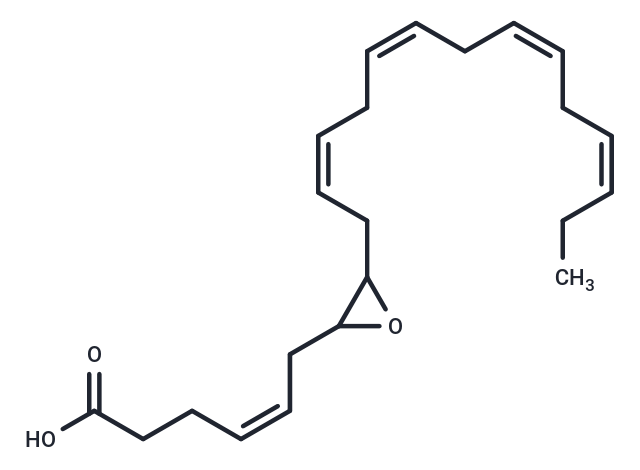 Your shopping cart is currently empty
Your shopping cart is currently empty

Docosahexaenoic acid is the most abundant ω-3 fatty acid in neural tissues, especially in the brain and retina. (±)7(8)-EpDPA is an epoxide derivative of DHA that is generated by the action of cytochrome P450 epoxygenases. It is naturally occurring in plasma and brain and spinal cord tissues and is increased following dietary supplementation with ω-3 fatty acids. (±)7(8)-EpDPA and other epoxy metabolites of DHA modulate receptor and channel activities to evoke diverse effects, such as promoting vasodilation, inhibiting angiogenesis, and decreasing inflammatory and neuropathic pain. (±)7(8)-EpDPA is a substrate of soluble epoxide hydrolase (KM = 15 μM), which converts it to the corresponding diol.

| Pack Size | Price | USA Warehouse | Global Warehouse | Quantity |
|---|---|---|---|---|
| 25 μg | $142 | 35 days | 35 days | |
| 50 μg | $282 | 35 days | 35 days | |
| 100 μg | $526 | 35 days | 35 days | |
| 500 μg | $2,320 | 35 days | 35 days |
| Description | Docosahexaenoic acid is the most abundant ω-3 fatty acid in neural tissues, especially in the brain and retina. (±)7(8)-EpDPA is an epoxide derivative of DHA that is generated by the action of cytochrome P450 epoxygenases. It is naturally occurring in plasma and brain and spinal cord tissues and is increased following dietary supplementation with ω-3 fatty acids. (±)7(8)-EpDPA and other epoxy metabolites of DHA modulate receptor and channel activities to evoke diverse effects, such as promoting vasodilation, inhibiting angiogenesis, and decreasing inflammatory and neuropathic pain. (±)7(8)-EpDPA is a substrate of soluble epoxide hydrolase (KM = 15 μM), which converts it to the corresponding diol. |
| Molecular Weight | 344.495 |
| Formula | C22H32O3 |
| Cas No. | 895127-66-9 |
| Storage | Powder: -20°C for 3 years | In solvent: -80°C for 1 year | Shipping with blue ice/Shipping at ambient temperature. | ||||||||||||||||||||||||||||||||||||||||
| Solubility Information | PBS (pH 7.2): 1 mg/mL (2.9 mM), Sonication is recommended. DMSO: 50 mg/mL (145.14 mM), Sonication is recommended. Ethanol: 50 mg/mL (145.14 mM), Sonication is recommended. DMF: 50 mg/mL (145.14 mM), Sonication is recommended. | ||||||||||||||||||||||||||||||||||||||||
Solution Preparation Table | |||||||||||||||||||||||||||||||||||||||||
PBS (pH 7.2)/DMSO/Ethanol/DMF
DMSO/Ethanol/DMF
| |||||||||||||||||||||||||||||||||||||||||
| Size | Quantity | Unit Price | Amount | Operation |
|---|

Copyright © 2015-2025 TargetMol Chemicals Inc. All Rights Reserved.